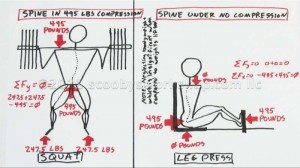Squat Myths
“All bodybuilders must do squats” / “There is no substitute for squats” / “Leg press isn’t nearly as effective as squats” / “Squats increase testosterone and growth hormone”
First of all, don’t get the wrong idea – squats are a great exercise! Squats are a great mass-building, compound exercise that work the quads, hamstrings, glutes, core while enlisting many smaller stabilizing muscles as well. Its an exercise that only requires an olympic bar and a rack which are available at virtually every gym in the world. If you ask any pro powerlifter or bodybuilder, they will probably list it as the #1 most important exercise. But squats are not magical as lore has made them out to be and they are definitely not for everyone. Squats are great if you:
- you are over 18 and under 40 years old
- you have been trained by a professional powerlifting coach
- you, your parents, and your grandparents have no history of back problems
- you have either a squat cage with safety catch bars set at hip height or higher Otherwise, skip the squats and use leg machines and play sports!
With that out of the way, lets look at these myths surrounding squats:
Myth 1) All bodybuilders must do squats.
OK, those who have ever taken a SAT preparatory course can figure this one out even if they know nothing about bodybuilding. Statements that have definitive words like always, never, must, etc, are usually wrong. The world is rarely a white and black place, its shades of gray. This statement has two strong definitive words “all” and “must”, if you were answering this on a SAT test you would guess “False” and you would be correct. For many people doing squats is dangerous. Bone density degrades with age, older people should not squat. Young teens should not squat either. People with a history of back problems in their family should not do squats. These people with back problems should use machines like the leg press because the leg press is far superior to squats when it comes to back safety.
Remember from your high school physics that the sum of the forces in the X,Y, and Z directions must be zero. If you have a 495 pound bar sitting across your shoulders in a squat then the ground must be pushing back up with an equal but opposite 495 pounds of force to keep you from sinking into the floor. Therefore, your spine is under 495 pounds of compression – 495 pounds of force pushing from each end. Now lets look at a leg press machine. Its set to the same weight so the foot pad is pushing with 495 pounds of force. The difference here is that the opposing 495 pounds of force is being applied at the hips. The sum of the forces again is zero and the legs are under 495 pounds of compressive force just as in the squats. The difference is that the spine here is under no compressive stress at all. Zero pounds on the head is counterbalanced by zero pounds pushing from the seat.
So, the main difference between squat and a leg machine is that in the leg press, the spine is under no compressive load whereas in the squat, the spine is supporting the full weight. With squats, the stronger your legs are, the more weight you need to use and the more compressive load your spine is under. With leg press, even the strongest powerlifter in the world has no compressive stress on their spine. Not everyone’s back can withstand that immense compressive force from squatting. Good technique and a strong core can lessen the spinal compression somewhat but squats compress the spine – period. Human spines are poorly designed for handling vertical compressive loads, its one of the reasons why 10.2% of the population has debilitating chronic back pain. Our spines are much better designed for being horizontal and on all fours like a horse. So, should you do squats or not??? Squats ARE a great exercise but they are not for everyone.
Myth 2) There is no substitute for squats
Passions run really high with squats and for those who do them, its almost like a religion. Their mantra often is “There is no substitute for squats”. The reason given is that because squats involve balance, they are a whole body exercise working the small stabilizing muscles as well as all the large leg muscles. I find it interesting that most of the people making this claim are self-proclaimed gym-rats, that is, people who don’t do any sports outside the gym. There are substitutes for squats but they don’t like them. A safe and effective substitute for squats is to do leg press, leg curls and then a game of basketball, soccer, volleyball, rugby, hockey, or lacrosse to work the stabilizing muscles. Squats are great but they are not magical!
Myth 3) Leg press isn’t nearly as effective as squats
I get really tired of this myth. First of all, look at the below diagram:
People use the argument that since they can do way more weight on the leg press than they can on the squat that this makes the squat a better, “more efficient” exercise. This ridiculous claim shows the complete lack of understanding of basic physics by bodybuilders and the public at large. If you really want to succeed at bodybuilding, you need to know your science! In the case of the 45 degree leg press, its simple leverage that lets you lift more than you can squat. To get 495 pounds of resistance for your legs in the 45 degree leg press requires loading the machine with 700 pounds of weight (495/cosine(45)). In addition, the squatter is lifting their own bodyweight in addition to the 495 pound bar, this is not the case for the leg presser. If the bodybuilder pictured weighs 200 pounds, their legs are really lifting closer to 695 pounds when squatting so when doing the leg press they would need to do 980 pounds (695/cosine(45)) on the leg press to get the same leg workout. So for this 200 pound bodybuilder, 495 pounds on the squats is about the same as 980 pounds on the 45 degree leg press – not because squats are ‘more effective’ but because of physics.
4) Squats increase testosterone and growth hormone
Well yes and no. I saved this one till last because this one causes lots of confusion. The squat advocates would have you believe that only squats can increase testosterone and growth hormone which allows the entire body to pack on massive amounts of muscle mass. Lets look at the facts first. Yes, all types of strenuous resistance training (not just squats) cause a temporary increase in testosterone and growth hormone – a few hours to a day. The big question is if this temporary spike is enough to make a difference in the ability of your body to add muscle, more on this later.
Second, it is reasonable to assume that the amount of hormones released are proportional to the stress put on the body, that is, ear-wiggles are not going to release as much testosterone as squats. The amount of stress put on your muscles is probably proportional to the amount of force times the distance that force was moved. If you look again at the above diagram, the bodybuilder doing the squats will release just as much testosterone as the bodybuilder doing leg press because they are both pushing with 495 pounds of force and moving down the same distance. Squats do not have a monopoly on raising testosterone levels.
Now that the myths are out of the way, lets look at why the powerlifters have something here. The squat does raise testosterone but the effect is temporary, so why don’t we do squats everyday twice a day? That way the natural testosterone level will be raised all week long! Wrong! Overtraining is an injury and not only will the testosterone levels not be elevated but your legs will atrophy. So, what exercises other than squats can we also use to keep the testosterone levels naturally elevated – well chest is another big muscle that can move a lot of weight, how about bench press? Again the testosterone released is probably proportional to the weight moved times the distance it moves. So heavy squats, heavy bench, … this is beginning to sound like a powerlifting workout isn’t it? But powerlifting doesn’t have a monopoly on heavy lifting, its just that powerlifters are often more motivated and hardcore than machine users. Its that hardcore mindset and focus that is necessary to pack on muscle mass and powerlifters have it. There is no reason that you cant get just as strenuous a workout from machines and release the same amount of testosterone but you gotta put your head down, furl your brow, and grunt. When it all boils down, there is nothing exciting or revolutionary here. Workout consistently and give each set 110% effort till blood comes out your pours and you will maximize your ability to gain muscle mass whether you are powerlifting or using machines.

